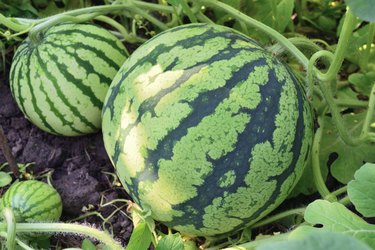
The Sugar Baby watermelon (Citrullus lanatus 'Sugar Baby') produces small, icebox-size fruits with green-on-green rinds and sweet red flesh. The 6- to 8-foot-long vines and 9-inch-diameter fruits make it easy to grow this summer annual in containers and small gardens. Watermelons need an organically rich soil, full sun, and plenty of water to thrive in the garden.
About the Sugar Baby Watermelon
Video of the Day
Watermelons originated in southern Africa. The indigenous peoples of the Kalahari Desert region used these juicy fruits as a source of water, but the flesh was bitter. The Egyptians developed the watermelon using traditional plant breeding methods to encourage sweeter flesh and larger fruits. Over time, the seeds and fruits were carried by traders to India, China, Europe and across the Atlantic to the Americas.
Video of the Day
In the 20th century, small-fruited and seedless cultivars were developed by plant breeders. At 8 to 10 pounds and approximately 9 inches in diameter, Sugar Baby watermelon is just the right size for the old-fashioned icebox or a modern refrigerator. It was released to the public in 1956. There is also a Bush Sugar Baby cultivar with 24- to 36-inch-long vines, which is a good choice for extremely tight spaces.
Selecting the Container
When selecting a container for your Sugar Baby watermelon, consider the weight, size, and planter materials. Wood and clay pots wick the moisture from the soil on hot days, while glazed ceramic and plastic pots help retain water. Plastic pots are lightweight, which is a consideration when growing watermelons on a balcony.
The container should be at least 18 to 24 inches wide and equally deep to accommodate the plant's root system. It can be round, square, or rectangular depending on the size and shape of your patio or balcony.
Preparing Soil for Watermelons
Watermelon plants require a well-drained, organically rich soil. Use a commercially prepared potting soil or mix your own using equal parts compost, coconut coir or peat moss, and coarse sand or perlite.
Place the container in full sun. Space multiple planters so the vines will be 3 feet apart. Moisten the potting mix and then fill the container to within 2 inches of the rim.
Planting Sugar Baby Watermelon Seeds
Plant seeds three weeks after the last frost date and when soil temperatures are at least 70 degrees Fahrenheit. Alternatively, plant seeds indoors in paper or peat pots six weeks before your projected transplant date outside.
Press three or four seeds 1 inch deep and 4 inches apart into the moist potting mix. Keep the mix moist as the seeds germinate, usually within five to 10 days. After the seedlings have developed three or four true leaves, use sterilized scissors to snip off all except one or two of the strongest plants.
Growing Watermelon Vertically
Install a sturdy 6 x 6- or 8 x 8-foot trellis next to the planter. Whether wood, wire, or PVC, use spacers to allow at least 1 inch of space between the trellis and the wall or fence so you can tie the watermelon vines to the structure as they grow. Sugar Baby watermelons can weigh as much as 10 pounds. As the fruits develop, add net bags or slings to support the watermelons.
Caring for Sugar Baby Watermelons
Keep the planting mix evenly moist, applying at least 1 to 2 inches of water weekly. Containers dry out quickly, so check the mix daily and water when the top 1 to 2 inches of the mix is dry. Avoid wetting the leaves to help discourage powdery mildew and other fungal diseases.
Fertilize with a slow-release 10-10-10 fertilizer after thinning the seedlings or apply a half-strength 5-10-10 liquid fertilizer solution, compost tea, or diluted fish emulsion every two weeks through the growing season. Always water thoroughly after fertilizing.
Monitor for pests, such as aphids and beetles. Hand pick beetles or if necessary, apply a ready-to-use neem oil spray or insecticidal soap according to the package directions.
Harvesting the Watermelons
When the tendrils on the vines turn brown, it's almost time for the Sugar Baby watermelon harvest. Reduce watering for seven days and then harvest the fruits by cutting the stem with garden pruners. Store whole watermelons in the refrigerator for up to one week and sliced fruits for four days.